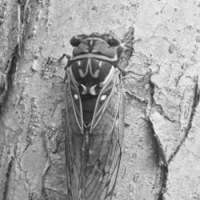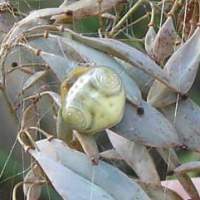T he first time I ever heard cicadas was in 1963, during my very first summer in Japan. I was wandering through a small mixed woodland where some small boys were flitting from tree to tree, playing ninja. I, as a strange young foreigner passing through, became their target for assassination. Being just a 23-year-old kid myself, and already hooked on ninja and samurai movies, I joined in the game.
Then a terrific "mee-mee-meeee" racket started up all around, and I stopped and asked one of my new playmates what it was. The lad looked at me as if I was daft and said "semi." I had a small dictionary with me, so I looked the word up and found it meant "cicada." I knew the word, as I'd read it in books, but I'd never encountered cicadas in Britain — and certainly not in the Arctic, where I had spent a lot of my time since being 17 — and I didn't really know what it was.
So I asked the lad, in my simple Japanese, "What is a cicada? Is it a frog — or a bird?"
He looked at me as if I was daft, not even deigning to answer such a dumb question. Instead, he pointed at a tree nearby. "Look. That's a cicada," he announced.
I stared and stared but could see nought but tree bark, branches, twigs, leaves and the occasional meandering ant. No sign of a chirruping frog or trilling bird; nothing that could make such a buzz-saw racket. The lad pointed again. "That. There." He didn't actually say "stoopid" — but I felt it in his tone.
Finally I saw a perfectly camouflaged insect a meter in front of my nose, buzzing and mee-mee-meeeing for all it was worth.
Mating and dying
The little boy then started to try to explain the life cycle of the cicada, relating the many years the nymph spends underground, and then the very short time it lives above ground as an adult before mating and dying. I was absolutely fascinated, and that lad, no more than 10 years old at the time, was my first Japanese biology teacher.
Since then, I have associated the sounds of cicadas with summer in Japan — with one exception. Back in the late 1960s, when I was Game Warden of the Simien Mountain National Park in Ethiopia, I discovered cicadas, way up in the giant heather woods at altitudes of around 3,500 meters.
My house, at the base camp in Sankabar, was on the edge of the escarpment and surrounded by wonderful Afro-alpine woodlands. In the rainy season we would often be way up in the clouds, surrounded by chilly thick fog that condensed in my beard when the rain stopped and the wind ceased, and at times like that the high-pitched metallic whine of the cicadas was deafening. They were very hard to find, despite the noise, for they were wondrously camouflaged. They were coloured dark brown, with a wet-looking sheen; the body blotched with yellow-green markings. The wings were semi-transparent, with the whole color and patterning being that of wet tree bark and lichens.
The first time I found one, even though thousands were buzzing steadily all around me in the foggy wet woods, I had stared at a tree for more than two minutes before my brain registered what my eyes saw. I never heard those Simien cicadas in the dry season. And when I asked the rangers, even the locally born men said they had never seen one.
This summer, in our woods here in Kurohime, we have had a lot of cicadas called in Japanese Ezo zemi. As "Ezo" is the old name for Hokkaido, I thought it was rather a poor name for cicadas living up here in the Nagano Prefecture hills. So did the children who visit us on our various programs. One little boy, looking at one of these creatures on a tree trunk, spotted the insect's characteristic yellow marking and called it a "makudonarudo zemi" (McDonald's semi), and since then the name has stuck.
Me, I'd seen the same marking and thought it looked more like the Chinese character for "mountain," but the boy who first named it told me to look at it upside down. Maybe the world-famous fast-food chain should adopt it as a good-luck symbol for summer — and in the meantime, put aside some money for woodland conservation and children's woodland projects?
In Japanese especially, insects and other creepy-crawlies get some extraordinary names. For example, we were walking in our woodlands the other day when a visitor from Wales spotted the strangest looking creature on a tall plant. He called me over, and at first glance it seemed to be the decapitated head of a praying mantis. Then he pointed out that it had legs, and a really close look revealed that it was a fat, greenish-looking spider.
My friend, Christian Searle, took a picture, and when we showed it to Mr. Matsuki, the forester, he said that it was a "fun damashi." That translates as a "false or fake turd or dropping." I thought it was his personal nickname for the beast, but when our staff looked it up on the Internet, we found that the spider's real name in Japanese is otori fun damashi — a heck of a mouthful, whose translation comes out as "greater false bird poo." I kid you not. I couldn't find the English name for this spider, but the Latin name is Cyratarachne inaequalis.
There are several species of these strange-looking spiders, and they often sit out on the top of leaves, not at all shy and, according to Mr. Matsuki, well protected because they look like unappetizing bird droppings to birds and hornets. To me, though, this one looked more like a mantis head. What do you think?




















With your current subscription plan you can comment on stories. However, before writing your first comment, please create a display name in the Profile section of your subscriber account page.